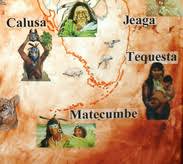The Tequesta lived in the southeastern parts of present-day Florida. They had lived in the region since the 3rd century BCE (the late Archaic period of the continent), and remained for roughly 2,000 years, having disappeared by the time that Spanish Florida was traded to the British, who then established the area as part of the province of East Florida.
The Tequesta tribe lived on Biscayne Bay in what is now Miami-Dade County and at least until Pompano Beach. Their territory may have also included the northern half of Broward County and southern and central Palm Beach County. They also occupied the Florida Keys at times, and may have had a village on Cape Sable, at the southern end of the Florida peninsula, in the 16th century. Their central town (called "Tequesta" by the Spaniards in honor of the chief) was on the north bank of the Miami River. A village had been at that site for at least 2,000 years. The Tequesta situated their towns and camps at the mouths of rivers and streams, on inlets from the Atlantic Ocean to inland waters, and on barrier islands and keys.
The Tequesta were more or less dominated by the more numerous Calusa of the southwest coast of Florida. The Tequesta were closely allied to their immediate neighbors to the north, the Jaega. Estimates of the number of Tequesta at the time of initial European contact range from 800 to 10,000, while estimates of the number of Calusa on the southwest coast of Florida range from 2,000 to 20,000. Occupation of the Florida Keys may have swung back and forth between the two tribes. Although Spanish records note a Tequesta village on Cape Sable, Calusa artifacts outnumber Tequesta artifacts by four to one at its archaeological sites.
On a map the Dutch cartographer Hessel Gerritsz published in 1630 in History of the New World, the Florida peninsula is labeled "Tegesta" after the tribe. A map from the 18th century labeled the area around Biscayne Bay "Tekesta". A 1794 map by cartographer Bernard Romans labeled this area "Tegesta".
